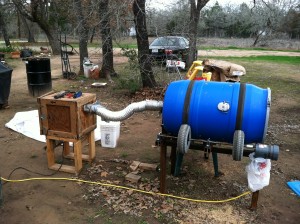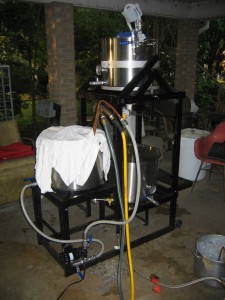Smoked beers are another style of beer that homebrewers either love or hate. Brewers are either enraptured by the smoky character, reminiscent of barbecue, or say the beer tastes like an ashtray. If you like smoky beers, there are commercially-smoked malts available, including Weyermann’s Rauchmalz (smoked with beechwood), Briess’ Cherrywood Smoked Malt and peat-smoked malts from various maltsters. However, if you’d like smoked malt from the hardwood of your choice, smoking your own malt at home is very straightforward.
I’ve smoked malt at my house on my Weber grill before. However, before writing this article, I spoke to Kevin Glenn, who not only brews professionally at Bastrop Brewhouse, but smokes small lots of malt for various breweries. Kevin’s birchwood-smoked malt went into Jester King’s Gotlandsdricka.
Kevin’s malt smoking setup is based around a 55-gallon drum (that formerly held liquid malt extract). The drum sits on four wheels that rotate the drum to stir the malt. There is a hole cut in the side of the drum, that seals with a Corny keg lid, so malt can be poured (through a funnel) into the drum. To the side, a hot box holds the heat source and hardwood.
Kevin cold smokes his grain, so the malt is only exposed to a little heat. He smokes two sacks of malt (100 lbs./45 kg) at a time, but only burns 3 or 4 charcoal briquettes to do so. The briquettes sit in a cast iron pan and heat the hardwood chunks, which are soaked in water so they will smoke. Before pouring the malt into the drum, he pours 4 cups of water over it and mixes it to even out the moisture. This moisture helps the smoke stick to the grain. Kevin runs his malt smoker for 3 to 4 hours, by which time the moisture has evaporated.
You can smoke malt on a smaller scale with just a grill or BBQ smoker. Here’s how.




Recent Comments